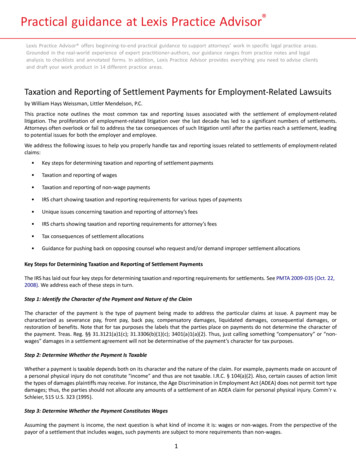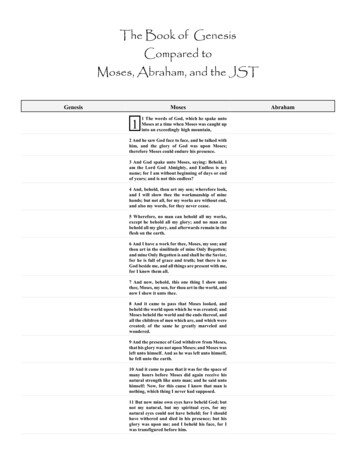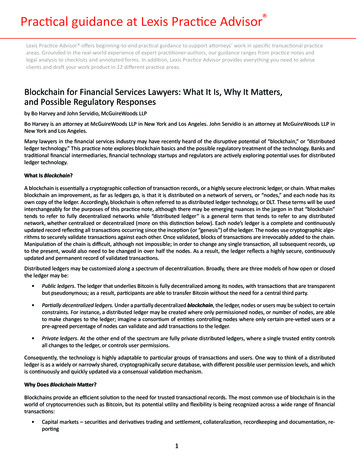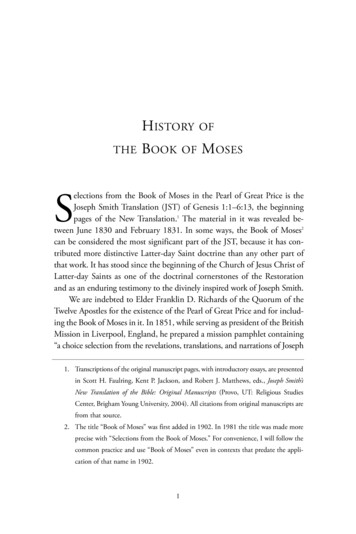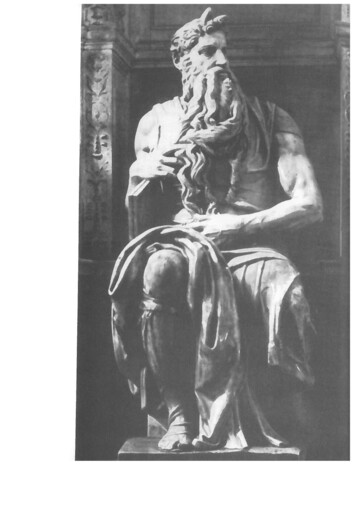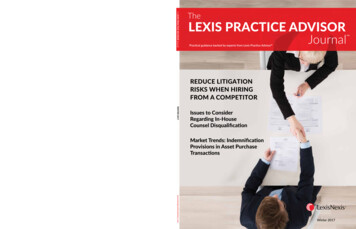
Transcription
The LEXISLexis Search Advantage PRACTICE ADVISOR JournalTMYOUR ENTIRE DOCUMENTUNIVERSEREDUCE LITIGATIONRISKS WHEN HIRINGFROM A COMPETITORINTERNAL & LEXISNEXIS CONTENT SEARCHED & ENHANCEDMORE THAN 30 MILLIONWINTER 2017replacement to comeIssues to ConsiderRegarding In-HouseCounsel DisqualificationMarket Trends: IndemnificationProvisions in Asset PurchaseTransactionsLE XI S N E XI S .CO M /A DVA N TAG E8 8 8 . 2 53 . 39 0130M AG N OST ICSOFTWA R ED OCU ME N T S W IT HON E SE A RCHS H E PARD IZEI N - H OU SE D OCS QUICKI MPL E M E N TAT I O NLexisNexis, Lexis, Shepardize and the Knowledge Burst logo are registered trademarks of Reed Elsevier Properties Inc., used under license. 2016 LexisNexis. PA00204-0 1016www.lexispracticeadvisor.comStart your free trial todayWinter 2017
ContentsWINTER 2017PRACTICE NEWSP R A C T I C E N OT E S4 A BRIEFING ON EMERGING ISSUESIMPACTING TRANSACTIONAL PRACTICE38 BANK REGULATION AND COMMERCIALLENDINGCommercial Transactions, Finance, Labor & Employment,Real EstateFinance44 LENDER LIABILITY UNDER ENVIRONMENTALLAWS IN REAL ESTATE TRANSACTIONSPRACTICE POINTERS10 BEST PRACTICES TO REDUCELITIGATION RISKS WHEN HIRINGFROM A COMPETITORLabor & Employment20 PROTECTING TRADE SECRETS ANDCONFIDENTIAL INFORMATIONWHEN HIRINGLabor & Employment23 DRAFTING AND REVIEWING THE KEYDOCUMENTATION FOR A PRIVATEEQUITY FUND AND ITS OFFERINGCorporate and Mergers & AcquisitionsReal EstatePRACTICE PROFILE58 A LOOK INTO DIGITAL MEDIA'S INFLUENCEON BRAND IDENTITY AND INTELLECTUALPROPERTY RIGHTS WITH PO YIIntellectual Property & TechnologyIN-HOUSE INSIGHTS62 ISSUES TO CONSIDER REGARDINGIN-HOUSE COUNSEL DISQUALIFICATIONCorporate CounselP R A C T I C E P R OJ E C T I O N SPRACTICE TRENDS28 THE IMPACT OF "CASH-IN-LIEU OFBENEFITS" PAYMENTS TO EMPLOYEESON OVERTIME COMPENSATIONCALCULATIONSLabor & Employment32 COMPENSATION EXCLUDED FROMREGULAR PAY RATESLabor & Employment34 GUIDANCE ON RANSOMWARE ATTACKSIntellectual Property & Technology1066 PATENT LITIGATION STRATEGIES AGAINSTPATENT TROLLSIntellectual Property & Technology73 MARKET TRENDS: INDEMNIFICATIONPROVISIONS IN ASSET PURCHASETRANSACTIONSCorporate and Mergers & AcquisitionsO N B OA R D79 PROFILES OF LEXIS PRACTICE ADVISORJOURNAL ADVISORY BOARD MEMBERSANDREW BETTWY & ALEXANDRAMARGOLISTM6273
E D I TO R I A L A DV I S O RY B OA R DWINTER 2017 (Volume 2, Issue 1)EDITOR-IN-CHIEFEric BourgetVP, LEXIS PRACTICE ADVISORRachel TraversAND ANALYTICALVP, ANALYTICAL LAWAileen Stirling& LEGAL NEWSDIRECTOR OFJae W. LeePRODUCT MARKETINGMANAGING EDITORPUBLISHING DIRECTORDESIGNERLori SieronAnn McDonaghJennifer ShadboltCONTRIBUTING EDITORSFinanceBanking LawCapital MarketsCommercial TransactionsRobyn SchneiderMatthew BurkeBurcin ErenAnna HaliotisDistinguished Editorial Advisory Board Members for The LexisPractice Advisor Journal are expert practitioners with extensivebackground in the transactional practice areas included in LexisPractice Advisor . Many are attorney authors who regularly providetheir expertise to Lexis Practice Advisor online and have agreed tooffer insight and guidance for The Lexis Practice Advisor Journal.Their collective knowledge comes together to keep you informedof current legal developments and ahead of the game when facingemerging issues impacting transactional practice.Andrew Bettwy, PartnerJoseph M. Marger, PartnerJulie M. Capell, PartnerAlexandra Margolis, PartnerCandice Choh, PartnerMatthew Merkle, PartnerProskauer Rose LLPFinance, CorporateDavis Wright Tremaine LLPLabor & EmploymentGibson Dunn & Crutcher LLPCorporate Transactions,Mergers & AcquisitionsS. H. Spencer Compton, VP,Special CounselFirst American Title Insurance Co.Real EstateLinda L. Curtis, PartnerCorporate Counsel, InternationalEdward BergerFinancial Restructuring & BankruptcyCody TrayGibson, Dunn & Crutcher LLPGlobal FinanceEmployee Benefits& Executive CompensationBradley BenedictTyler B. Dempsey, PartnerIntellectual Property & TechnologyJessica McKinneyLabor & EmploymentElias KahnMergers & AcquisitionsDana HamadaOil & Gas, JurisdictionalCameron KinvigReal EstateTaxLesley VarsJessica KernerASSOCIATE EDITORSMaureen McGuireMary McMahonErin WebreckTed ZwayerPRINTED BYCenveo Publisher Services3575 Hempland RoadLancaster, PA 17601Troutman Sanders LLPMergers & Acquisitions, JointVenturesJames G. Gatto, PartnerReed Smith LLPReal EstateNixon Peabody LLPBanking & FinanceKirkland & Ellis International LLPCapital MarketsTimothy Murray, PartnerMurray, Hogue & LannisBusiness TransactionsMichael R. Overly, PartnerFoley & LardnerIntellectual Property, TechnologyLeah S. Robinson, PartnerSutherland Asbill & Brennan LLPState and Local TaxScott L. Semer, PartnerTorys LLPTax, Mergers and AcquisitionsSheppard, Mullin, Richter &Hampton LLPIntellectual Property, TechnologyClaudia K. Simon, PartnerIra Herman, PartnerLawrence Weinstein,Corporate CounselBlank Rome LLPInsolvency and Commercial LitigationEthan Horwitz, PartnerCarlton Fields Jorden BurtIntellectual PropertyGlen Lim, PartnerProskauer Rose LLPFinance, CorporateSchulte Roth & ZabelCorporate, Mergers & AcquisitionsThe Children’s Place Inc.Kristin C. Wigness, First V.P.& Associate General CounselIsrael Discount Bank of New YorkLending, Debt Restructuring,InsolvencyPatrick J. Yingling, PartnerKing & SpaldingGlobal FinanceThe Lexis Practice Advisor Journal (Pub No. 02380; ISBN: 978-1-63284-895-6) is a complimentary publication published quarterly for Lexis Practice Advisor subscribers by LexisNexis, 230 Park Avenue,7th Floor, New York, NY 10169. Email: lexispracticeadvisorjournal@lexisnexis.com Website: www.lexisnexis.com/lexispracticeadvisorjournalThis publication may not be copied, photocopied, reproduced, translated, or reduced to any electronic medium or machine readable form, in whole or in part, without prior written consent of LexisNexis.Reproduction in any form by anyone of the material contained herein without the permission of LexisNexis is prohibited. Permission requests should be sent to: permissions@lexisnexis.com.All information provided in this document is general in nature and is provided for educational purposes only. It may not reflect all recent legal developments and may not apply to the specific facts andcircumstances of individual cases. It should not be construed as legal advice. For legal advice applicable to the facts of your particular situation, you should obtain the services of a qualified attorney licensedto practice in your state.The publisher, its editors and contributors accept no responsibility or liability for any claims, losses or damages that might result from use of information contained in this publication. The views expressedin this publication by any contributor are not necessarily those of the publisher.Send address changes to: The Lexis Practice Advisor Journal, 230 Park Avenue, 7th Floor, New York, NY 10169. Periodical Postage Paid at New York, New York, and additional mailing offices.LexisNexis, the Knowledge Burst logo and Lexis Practice Advisor are registered trademarks and Lexis Practice Advisor Journal is a trademark of Reed Elsevier Properties Inc., used under license. Otherproducts and services may be trademarks or registered trademarks of their respective companies.Copyright 2017 LexisNexis. All rights reserved. No copyright is claimed as to any part of the original work prepared by a government officer or employee as part of that person’s official duties.Cover photo courtesy Andrey Popov / Shutterstock.com. Additional images used under license from Shutterstock.com.2www.lexispracticeadvisor.com
I N - H O U S E I N S I G H T S Lexis Practice Advisor Corporate CounselDevika Kewalramani MOSES & SINGER LLPISSUES TOCONSIDERREGARDINGIN-HOUSE com
Federal and state courts have the power to disqualify a lawyer from continuing to representa client by requiring withdrawal when a disabling conflict of interest exists. While courtsare generally reluctant to impose this harsh remedy—recognizing a party’s right to choiceof counsel and a lawyer’s right to freely practice law—courts do not hesitate to disqualify alawyer when client loyalty is betrayed or client confidential information is unprotected.In-House Counsel DisqualificationLateral Move to Competitor’s Legal DepartmentDisqualification of in-house counsel is highly unusual. When theAfter seven years, In-house Counsel left Schlumberger to becomedisqualified in-house counsel’s conflict is imputed to other in-houselawyers and extended to reach outside counsel, the outcome can bedevastating. But it does happen, and lateral in-house lawyers needto be extra careful regarding conflicts baggage they may carry fromone corporate legal department to another.Recently, the United States Court of Appeals for the Federal Circuitaffirmed a district court’s disqualification of in-house counsel andoutside counsel due to a conflict of interest arising from an inhouse lawyer’s work for her new company in a patent infringementsuit against her former company in a “substantially related” matterinvolving communication of her former company’s confidentialinformation to other in-house counsel and outside counsel. Thedecision discussed below is particularly noteworthy for in-houseattorneys because of the district court’s treatment of plaintiff’scorporate legal department as a “law firm” for purposes of applyingconflicts of interest rules to disqualify counsel. See, Dynamic 3DGeosolutions LLC v. Schlumberger Ltd. (Schlumberger N.V.), 2016Senior Vice President and Associate General Counsel at AcaciaResearch Group LLC, an affiliate of Dynamic 3D GeosolutionsLLC, which was assigned the ‘319 patent acquired by Acacia’sparent company (collectively, Acacia). At her new company, Inhouse Counsel met with inventors of the ‘319 patent to discussits acquisition and possible future litigation, and participated inmeetings and telephone calls with other in-house counsel at Acaciaand with a law firm, Collins, Edmonds, Pogorzelski, Schlather &Tower PLLC (Outside Counsel) regarding the ‘319 patent andSchlumberger’s Petrel product as a potential target of the patentinfringement litigation. Thereafter, In-house Counsel approved arecommendation (prepared by other in-house counsel at Acacia andOutside Counsel) to Acacia’s CEO to acquire the ‘319 patent andsue Schlumberger.In a subsequent patent litigation against Schlumberger, In-houseCounsel and Acacia’s other in-house lawyer retained OutsideCounsel to handle all patent-related litigation. Then, Schlumbergerfiled a motion to disqualify counsel from the case on conflicts ofinterest grounds, which the district court granted, disqualifyingU.S. App. LEXIS 16645, 837 F.3d 1280 (Fed. Cir. 2016).In-house Counsel, the other Acacia in-house lawyer, andRoles & ResponsibilitiesOutside Counsel.In the Dynamic 3D case, an in-house lawyer (In-house Counsel) wasemployed as Schlumberger’s Deputy General Counsel for IntellectualProperty for seven years. In this position, she was responsible fordeveloping and implementing her company’s worldwide intellectualproperty (IP) strategy, protecting and preserving its IP assets(including patents, trademarks, and trade secrets), advising seniorexecutives on IP-related risks, enforcing IP litigation, and directingand supervising outside counsel on IP legal matters. She manageda copyright lawsuit involving her company’s software platform,Petrel, and worked on a “Goldstar” project evaluating the patentableaspects of Petrel while assessing the risk of lawsuits against it. Theproject also analyzed the ‘3191 patent held by a competitor that wasSubstantial Relationship TestOn appeal, the Federal Circuit analyzed Rule 1.09(a) of the TexasDisciplinary Rules of Professional Conduct (Texas Rule) and Rule1.9 of the corresponding American Bar Association Model Rules ofProfessional Conduct (ABA Model Rules), which prohibit a lawyerfrom being materially adverse to a former client in a “substantiallyrelated” matter where the lawyer acquired confidential informationof the former client, and from using it to the disadvantage of theformer client, unless permitted by the rules.The Federal Circuit affirmed the district court’s finding that In-houseCounsel’s prior work at Schlumberger was substantially related toher current work at Acacia, and rejected Acacia’s argument that sheformerly played a limited, supervisory role. The court agreed withused to turn seismic and well-log data into a real-time interactiveSchlumberger, which contended that In-house Counsel previouslythree-dimensional display.personally represented Schlumberger in litigation and licensing1. U.S. Patent 7,986,319.www.lexispracticeadvisor.com63
patent used to accuse her former employer’s product of patent“A CLIENT WOULD FEEL WRONGED IFAN OPPONENT PREVAILED AGAINSTHIM WITH THE AID OF AN ATTORNEYWHO FORMERLY REPRESENTED THECLIENTS IN THE SAME MATTER.”infringement.”5The Court noted that In-house Counsel, in her role as legal counselfor Acacia, admitted attending meetings with the inventors of the‘319 patent, other in-house counsel and Outside Counsel regardingits acquisition, and also admitted that Schlumberger’s Petrel productwas discussed at those meetings. In addition, the court observedthat In-house Counsel’s concurrence with the recommendation byother in-house counsel and Outside Counsel to acquire the ‘319patent and to sue Schlumberger would have “entailed assessingmatters, including leading a team that evaluated IP rights and risksrelating to Petrel, that she admitted acting in a legal capacity forAcacia at the initial meetings involving the ‘319 patent, and that theassessment of Petrel being a possible litigation target was clearlyrelated to her former work. The Court observed that “[t]he recorddocuments [In-house Counsel’s] involvement at Schlumbergerin a project specifically evaluating a product later accused ofinfringement by Acacia, and the risks of such an infringement suit.[In-house Counsel’s] representation at Schlumberger includedefforts to license Petrel when the later-accused features of theproduct existed in the older versions with which [In-house Counsel]was involved.”2Possession/Use of Confidential InformationSocietal Rights/Ethical Duties. In analyzing attorney disqualification,the Court acknowledged the important societal rights of a party’schoice of counsel and a lawyer’s freedom to practice his profession,but ultimately concluded that “there is an overriding countervailingconcern suffusing the ethical rules: a client’s entitlement to anattorney’s adherence to her duty of loyalty, encompassing a dutyof confidentiality . A client would feel wronged if an opponentprevailed against him with the aid of an attorney who formerlyrepresented the clients in the same matter.”3Irrebuttable Presumption. Schlumberger argued that “Fifth Circuitprecedent imposes an irrebuttable presumption that relevantthe patent’s value as a litigation tool against Schlumberger withknowledge of her former employer’s confidential information.”6Moreover, the Court pointed out that at oral argument, “Acaciaitself admitted that it failed to screen her from the case, and bothDynamic 3D and Acacia provided privilege logs evincing [In-houseCounsel’s] involvement in the present suit.”7Conflict Imputed to Other In-House CounselTreatment as a “Law Firm.” Next, the Federal Circuit examinedthe district court’s treatment of Acacia’s legal department as a“law firm” for purposes of applying the conflicts of interest rulesto impute In-house Counsel’s disqualification to other in-housecounsel within Acacia’s legal department. The Court reviewed TexasRule 1.09(b), which extends Texas Rule 1.09(a)’s restrictions on anindividual lawyer’s ability to undertake a representation againstthat lawyer’s former client to apply to all other lawyers who are orbecome members of or are associated with the “law firm” wherethat lawyer currently practices. Similarly, ABA Model Rule 1.10extends the prohibition to members of a lawyer’s new firm (unlessdisqualification can be cured by screening), and Comment 2 tothe rule emphasizes that each lawyer is “vicariously bound by theobligation of loyalty.”On this point, Acacia contended that Fifth Circuit precedent doesnot require a presumption of disclosure for in-house attorneyswhich should be based on the duty of loyalty resulting frompersonal representation, and further that there is no rationale for apresumption since none of Acacia’s “licensing executives” worked forconfidential information was acquired once prior and presentSchlumberger. In response, Schlumberger asserted that under Fifthrepresentations are shown to have been substantially related.”4Circuit law on conflicts imputation to other in-house counsel, theThe Federal Circuit agreed with Schlumberger, ruling that In-analysis turns on whether the conflicted attorney’s representationhouse Counsel was irrebuttably presumed to have possessedwas personal.Schlumberger’s relevant confidential information and disqualifiedFailure to Screen. The court rejected Acacia’s argument andher. The court reasoned that “[i]t was inappropriate [for Acacia] tohire a senior attorney, one intimately knowledgeable concerning aheld that regardless of whether the presumption of disclosurewas irrebuttable or rebuttable, Acacia was unable to rebut theparticular product, its competitors, its associated business strategiespresumption after admitting that it had not erected an ethical walland intellectual property, into a position in which she not onlyto prevent the flow of confidential communications from In-houseparticipated in but in fact played a significant role in acquiring aCounsel to Acacia’s legal department lawyers. The Court concluded2. Dynamic 3D Geosolutions LLC v. Schlumberger Ltd. (Schlumberger N.V.), 2016 U.S. App. LEXIS 16645, 837 F.3d 1280 (Fed. Cir. 2016) at 14. 3. Id. 4. Id. at 12. 5. Id. at 16. 6. Id. at 15. 7. Id. at 16. 8. Id.at21. 9. Id.at 22.64www.lexispracticeadvisor.com
that, “ethical standards are clear that lawyers similarly associateddisqualification without dismissal would greatly prejudice a partyhave had conflicts imputed to them.” The court reasoned that bybecause the case would be tried on a record developed primarilyattending meetings and deciding to hire Outside Counsel, In-housethrough the fruits of [the disqualified attorney]’s unethical labor.”13Counsel “communicated to the other in-house counsel that sheWatch Out or You’re All Out!8supported the litigation strategy and thereby disclosed confidentialinformation to other Acacia attorneys.”9 Significant to the Court’simputation analysis was the fact that other in-house counsel inAcacia’s legal department reported solely to In-house Counseluntil after the potential conflict was raised. This glaring conflictprecipitated the Court to impute In-house Counsel’s conflict onAcacia’s legal department to disqualify its other in-house counsel.Double Imputation: Conflict Stretched to Outside CounselConflicts of interest can disqualify lateral in-house lawyers whomove between legal departments the same way conflicts candisqualify outside counsel who move between law firms. Theconflicts imputation rules apply equally to legal departments and lawfirms and can have drastic implications on the disqualified lawyerand all other lawyers who may be contaminated by communicatingwith the disqualified lawyer, whether in the legal department orat a retained law firm. Legal departments and law firms shouldThe Federal Circuit further extended its imputation of In-houseconduct due diligence when initially hiring or working with in-houseCounsel’s conflict to disqualify Outside Counsel retained byor outside lawyers and constantly be on the lookout for potentialAcacia, rejecting Acacia’s argument that only actual disclosure ofconfidential information or substantive communications with InHouse Counsel warrants disqualification of Outside Counsel underFirth Circuit law. In affirming the “double imputation” to OutsideCounsel, the Court concluded that “there was sufficient evidenceof [In-house Counsel’s] involvement in the selection of [OutsideCounsel] . and in the litigation against Schlumberger to supporta finding of communication by conduct.” Furthermore, the Courtconflicts on the horizon before they become disqualifying conflicts.If conflicts actually arise, which they inevitably do, legal departmentsand law firms should take adequate steps to build proper ethicalwalls to safeguard client confidences. Otherwise, as case law shows,when the dust from disqualification settles, its practical impact oftenis the former client’s loss of confidential information and the newclient’s deprivation of counsel of its choice. A10found that “[In-house Counsel] disregarded the duty of loyalty andcommunicated confidential information not only to other in-housecounsel but also to outside counsel.”11Disqualification to DismissalDevika Kewalramani is a partner at Moses & Singer LLP and co-chairof its Legal Ethics & Law Firm Practice. Ms. Kewalramani focuses herpractice on legal ethics, professional discipline, risk management,and compliance. She serves as the chair of the Committee onProfessional Discipline of the New York City Bar Association.Ultimately, the Court dismissed without prejudice Acacia’scomplaint as “[a]ll aspects of the case were contaminated by[In-house Counsel’s] actions, from [Acacia’s] purchase of the ‘319patent, to preparation for suit against Schlumberger, to the actualfiling of the suit.”12 The Court ruled that “continuing the case afterRESEARCH PATH: Corporate Counsel Ethics for In-HouseCounsel Conflicts of Interest Articles Consequences ofFailing to Address Conflicts of Interest10. Id. at 25. 11. Id. 12. Id. at 27. 13. Id. at 28.www.lexispracticeadvisor.com65
2 www.lexispracticeadvisor.com The Lexis Practice Advisor Journal (Pub No. 02380; ISBN: 978-1-63284-895-6) is a complimentary publication published quarterly for Lexis Practice Advisor subscribers by LexisNexis, 230 Park Avenue, 7th Floor, New York, NY 10169.

